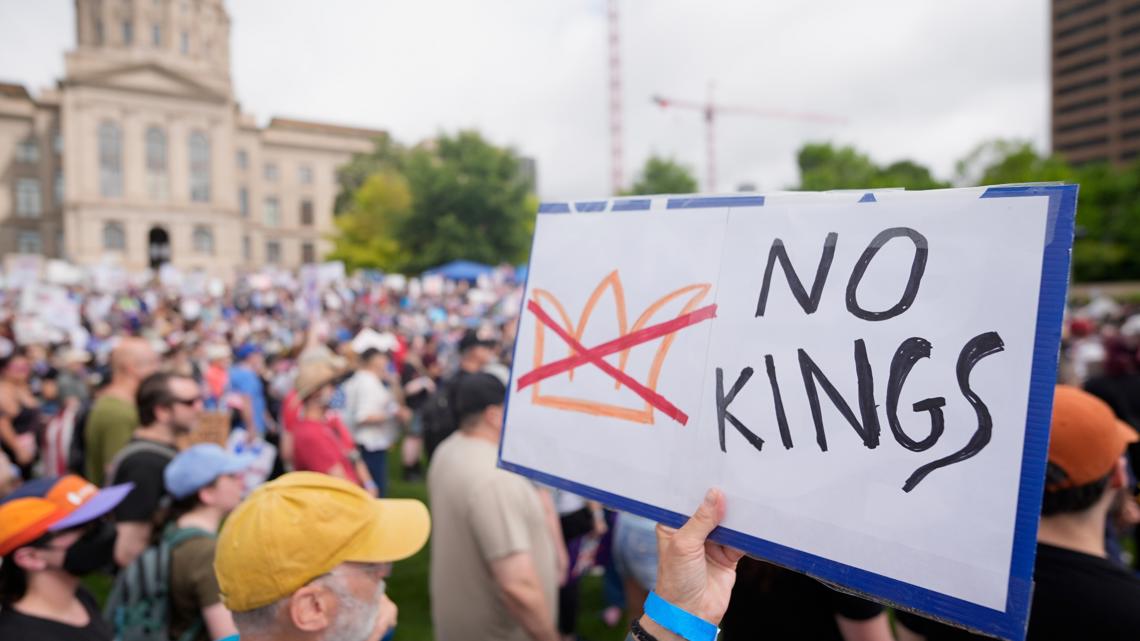The first No Kings Day was the largest single-day protest mobilization since Trump took office. The second will likely rival or even surpass the first.
WASHINGTON — Four months ago, millions of Americans held rallies across the U.S. to denounce the expansion of executive power under President Donald Trump, likening him to the British monarchs that the founders rebelled against to found the United States.
Now, organizers are planning a second “No Kings” protest, with more than 2,500 separate marches and rallies set to take place on Saturday, Oct. 18.
What is planned at the ‘No Kings’ protests?
People of all ages are expected to come together in the protest locations for speeches, marching, carrying signs and waving American flags, organizers said in a call Wednesday.
Demonstrations will vary by location, but many, including those in Washington D.C. and other large cities, will feature a march and rallies at the end of the route.
During the first event on June 14, huge, boisterous crowds marched, danced, drummed, and chanted shoulder-to-shoulder in New York, Denver, Chicago, Austin and Los Angeles, some behind “no kings” banners. Atlanta’s 5,000-capacity event quickly reached its limit, with thousands more gathered outside barriers to hear speakers in front of the state Capitol.
In some places, organizers handed out little American flags while others flew their flags upside down, a sign of distress. Mexican flags, which have become a fixture of the Los Angeles protests against immigration raids, also made an appearance at some demonstrations.
Are the ‘No Kings’ protests expected to be violent?
On the group’s website, it says a core principle behind all “No Kings” events is a commitment to nonviolent action, and participants are expected to seek to de-escalate any potential confrontation.
No weapons of any kind should be taken to “No Kings” events, according to the website.
At the first event in June, a counter-protester brandished a rifle at the “No Kings” rally in Salt Lake City, Utah.
Salt Lake City police said Arturo Gamboa brought an assault-style rifle to the rally and was allegedly moving toward the crowd with the weapon raised when a safety volunteer for the event fired three shots, wounding Gamboa and killing a nearby demonstrator, Arthur Folasa Ah Loo.
Salt Lake District Attorney Sim Gill’s office said a week later that it was unable to make a decision on charges against Gamboa, who had been jailed on suspicion of murder following the June 14 shooting.
How many people are expected to participate?
The first No Kings Day of Defiance was the largest single-day protest mobilization since Trump took office. Organizers said around 5 million Americans crowded the streets for the protests.
The second will likely rival or even surpass the first.
More than 2,500 individual events are registered with the organization’s website, with at least one in every U.S. state and commonwealth.
Why is it called ‘No Kings’?
The “No Kings” theme was orchestrated by the 50501 Movement, a national movement made up of everyday Americans who stand for democracy and against what they call the authoritarian actions of the Trump administration. The name 50501 stands for 50 states, 50 protests, one movement.
Protests earlier this year have denounced Trump and billionaire adviser Elon Musk, the former leader of Trump’s Department of Government Efficiency, a government organization designed to slash federal spending. Protesters have called for Trump to be “dethroned” as they compare his actions to those of a king and not a democratically elected president.
“They’ve defied our courts, deported Americans, disappeared people off the streets, attacked our civil rights, and slashed our services,” the group says on its website, referring to the Trump administration and its policies. “They’ve done this all while continuing to serve and enrich their billionaire allies.”
What’s different about this No Kings Day protest?
In the four months since the first protest, Trump and his administration have continued to crack down on both immigrants and political opponents.
Trump has sent the National Guard to several U.S. cities run by Democrats, sparking legal confrontations and backlash from both local officials and citizens.
Stephen Miller, the White House Deputy Chief of Staff, raised eyebrows earlier this month during a live CNN interview, when he claimed that Trump had “plenary authority” to deploy the National Guard in Oregon.
Plenary authority, according to Cornell University’s Legal Information Institute, is power “that is wide-ranging, broadly construed, and often limitless for all practical purposes.” In this case, it would be Trump having no rules to follow regarding when and where to deploy the National Guard in the U.S.
Under plenary authority, Trump may not be beholden to the courts or to Congress, and could direct any actions in the U.S. without consequence.
The Associated Press contributed to this story.

